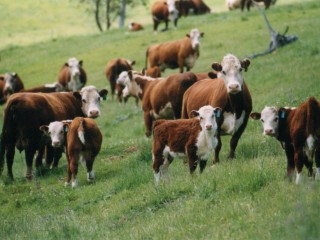 Have you ever given any thought to how much it costs you to produce a calf by a natural mating?
Have you ever given any thought to how much it costs you to produce a calf by a natural mating?
To work out costs per calf, we need to consider all the costs associated with purchasing and owning the bull. Purchase price is the obvious initial cost, but after that, we need to transport him home.
Many people will also choose to insure him (for at least the journey home), and once home we have to feed him.
The feed he consumes in the paddock is a cost that must be included.
Remember, if the bull was not eating your pasture, you could be running an additional cow/s and or steer/s.
For simplicity (in this example) we will not consider animal health costs, but these could be factored in if you wished; as could finance costs.
A worked example:
Example A
Let’s assume we purchase a $4000 bull. Transport and insurance costs are assumed to be $150.
Working life is 3 years, and the bull is sold at the end of his working life for $1200.
Cost of lost grazing is estimated at $500 per year. (Let’s assume that a bull eats the same amount as a breeding cow and that she produces a $500 weaner each year).
The calculation becomes:
Purchase price ($4000) + transport and insurance ($150) + the cost of lost grazing ($500 per year x 3years working life) = $5650 cost over 3 years.
Using the total cost ($5650) Subtract the salvage value ($1200), giving a Net Bull Cost of $4450.
Now that we have worked out the net costs of buying and owning the bull, we need to consider what he produces for us (i.e. the number of live calves).
If we assume the bull is used on 33 cows per year; the bull is used for 3 years; and the herd has an 85% calving rate, the bull will sire 85 calves in his working life.
We can now calculate the cost per calf. $4450 (Net Bull Cost) divided by 85 (the number of calves) = $52.50 per calf.
Having gotten this far, the obvious question to ask is “How do we get this cost down?”
Example B
Let’s say that by selecting and using structurally sound bulls we can increase their working life from 3 years to 5 years. Net bull cost will increase slightly since we need to feed him for 5 years rather than 3, but the number of calves sired in his lifetime will increase due to the longer working life, so:
33 cows/year x 5 years x 85% = 140 calves sired in working life
The cost per calf reduces to $38.90 per calf.
By using the bull for 5 years (rather than 3 years) we have reduced our cost per calf from $52.40 to $38.90 per calf. A reduction of 26% in the cost per calf !!
Can we reduce the cost per calf even more?
Example C
Let’s say that by using high fertility bulls with higher serving capacity, we can join the bull to 45 cows, rather than 33, and that we can also lift the calving rate from 85% to 90%. (Everything else stays the same as the previous examples.)
The number of calves sired in the bulls working lifetime will increase due to the greater number of cows mated per year and also due to the increased calving rate
45 cows/yr x 5 yrs x 90% = 202 calves
Cost per calf = $5450 ÷ 202 calves = $27.00
A saving of another 30% per calf!!)
So to summarise these examples:
- A $4000 bull used for 3 years on 33 cows with an 85% calving rate gave us costs of $54.40 per calf.
- Increasing his working life to 5 years reduced costs to $38.90 per calf.
- Increasing calving rate to 95% and mating to 45 cows reduced costs to $27.00 per calf.
The cost per calf has nearly halved!!!
But now consider an alternative outcome. Instead of purchasing a $4000 bull we could chose to purchase a $6400 bull. We will still use him for 5 years on 45 cows with a 90% calving rate;
Our net bull cost will increase to $7850 (due to the extra purchase price) but our cost per calf is still only $38.86.
Even though we are now using a $6400 bull, the costs per calf is still the same as a $4000 bull used for a shorter time and on fewer cows, with a lower calving rate.
In summary you can halve your bull costs by:
- Using sound bulls with longer working lives (5 years vs. 3 years).
- Using higher joining rates (45 vs. 33 cows).
- Ensuring better fertility in your bulls and females to achieve a 90% vs. 85% calving rate.
A full Bull Breeding Soundness Evaluation that uses the 5 fertility components (including the serving capacity test as described in the last edition of Beef news), can aid in selecting structurally sound and fertile bulls. NSW DPI also run “Better Bull Buying” workshops that can help
you identify suitable bulls, for your enterprise.
Better bull buying and management reduces bull costs, and those savings can be used to purchase bulls of higher genetic merit. Remember, the more calves a bull sires in his lifetime, the lower the costs per calf will be!!!
Source: Industry & Investment NSW Beef News Sep 2011
